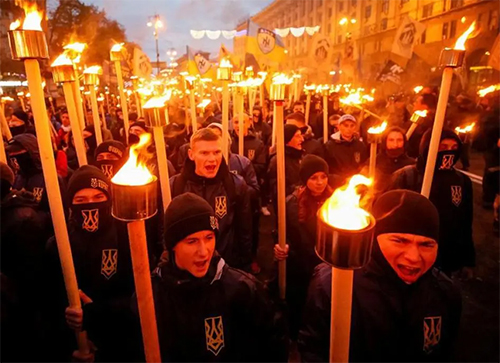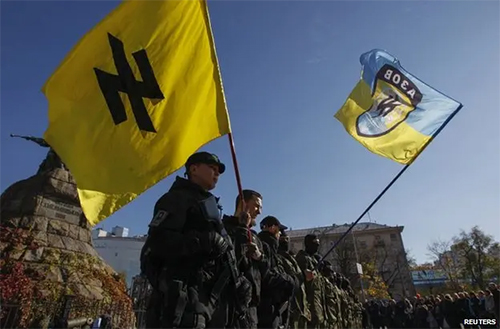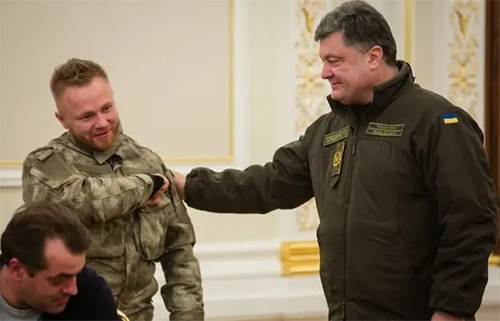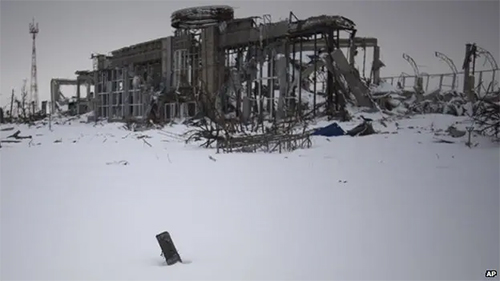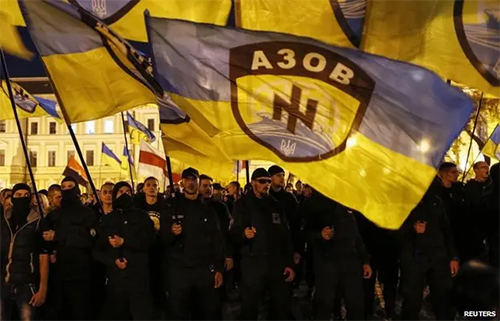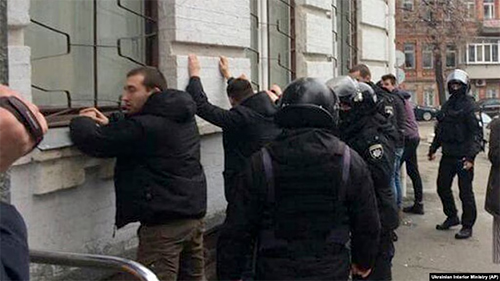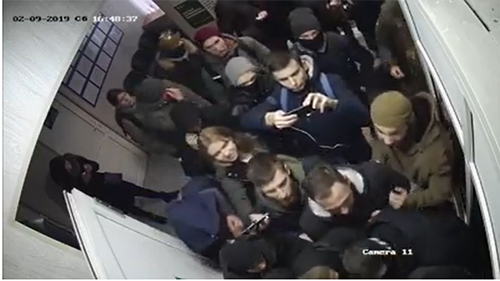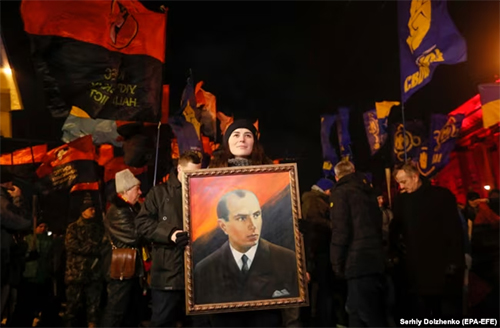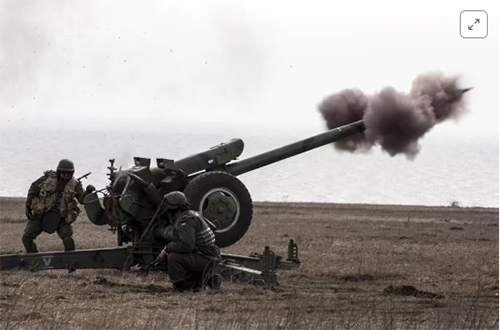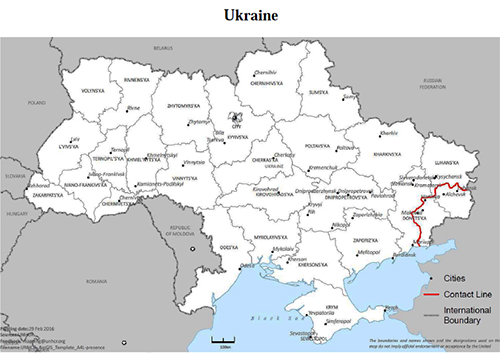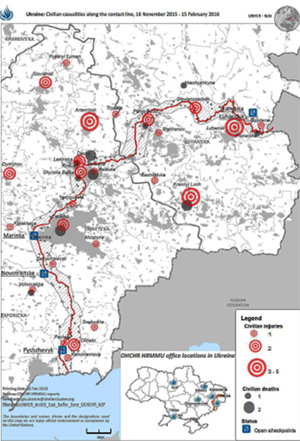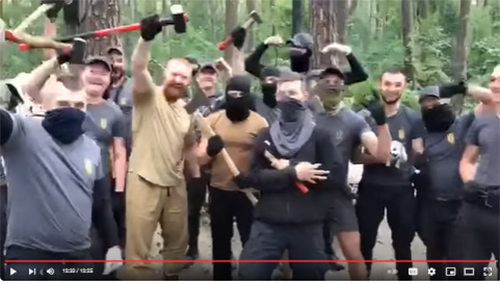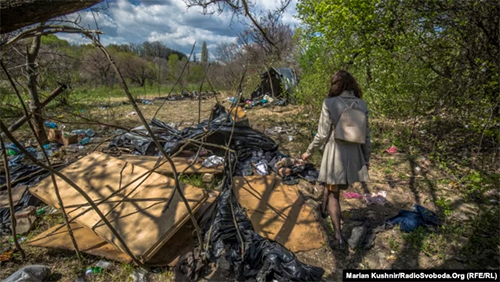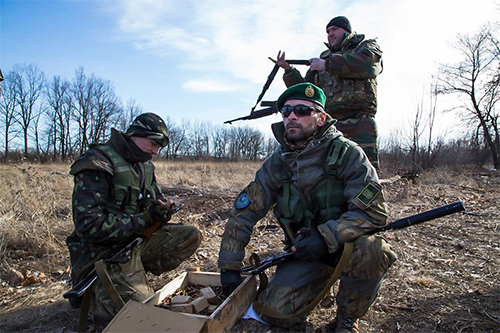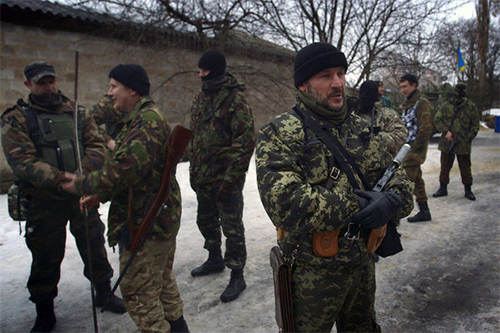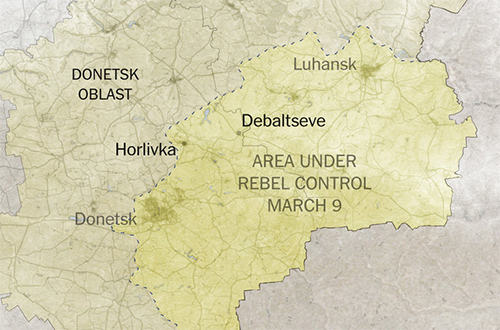Five years after the Maidan uprising, anti-Semitism and fascist-inflected ultranationalism are rampant.
Lev Golinkin
The Nation
February 22, 2019
https://www.thenation.com/article/polit ... t-ukraine/
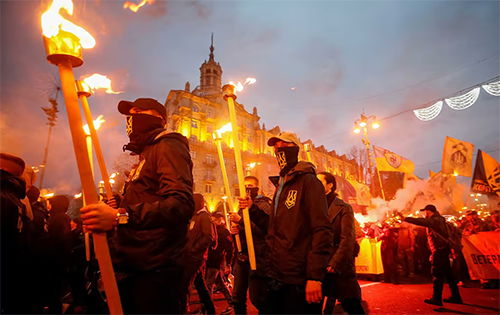
A march of the Azov Battalian, Svoboda, and other far-right radical groups in Kiev, October 14, 2017. (Reuters / Gleb Garanich)
Five years ago, Ukraine’s Maidan uprising ousted President Viktor Yanukovych, to the cheers and support of the West. Politicians and analysts in the United States and Europe not only celebrated the uprising as a triumph of democracy, but denied reports of Maidan’s ultranationalism, smearing those who warned about the dark side of the uprising as Moscow puppets and useful idiots. Freedom was on the march in Ukraine.
Today, increasing reports of far-right violence, ultranationalism, and erosion of basic freedoms are giving the lie to the West’s initial euphoria. There are neo-Nazi pogroms against the Roma, rampant attacks on feminists and LGBT groups, book bans, and state-sponsored glorification of Nazi collaborators.
These stories of Ukraine’s dark nationalism aren’t coming out of Moscow; they’re being filed by Western media, including US-funded Radio Free Europe (RFE); Jewish organizations such as the World Jewish Congress and the Simon Wiesenthal Center; and watchdogs like Amnesty International, Human Rights Watch, and Freedom House, which issued a joint report warning that Kiev is losing the monopoly on the use of force in the country as far-right gangs operate with impunity.
Five years after Maidan, the beacon of democracy is looking more like a torchlight march.
A neo-Nazi battalion in the heart of Europe. “Volunteer Ukrainian Unit Includes Nazis.”
—USA Today, March 10, 2015
The DC establishment’s standard defense of Kiev is to point out that Ukraine’s far right has a smaller percentage of seats in the parliament than their counterparts in places like France. That’s a spurious argument: What Ukraine’s far right lacks in polls numbers, it makes up for with things Marine Le Pen could only dream of—paramilitary units and free rein on the streets.
Post-Maidan Ukraine is the world’s only nation to have a neo-Nazi formation in its armed forces. The Azov Battalion was initially formed out of the neo-Nazi gang Patriot of Ukraine. Andriy Biletsky, the gang’s leader who became Azov’s commander, once wrote that Ukraine’s mission is to “lead the White Races of the world in a final crusade…against the Semite-led Untermenschen.” Biletsky is now a deputy in Ukraine’s parliament.
[url]https://www.ohchr.org/sites/default/files/Documents/Countries/UA/Ukraine_13th_HRMMU_Report_3March2016.pdfIn the fall of 2014, Azov—which is accused of human-rights abuses, including torture, by Human Rights Watch and the United Nations[/url]—was incorporated into Ukraine’s National Guard.
While the group officially denies any neo-Nazi connections, Azov’s nature has been confirmed by multiple Western outlets: The New York Times called the battalion “openly neo-Nazi,” while USA Today, The Daily Beast, The Telegraph, and Haaretz documented group members’ proclivity for swastikas, salutes, and other Nazi symbols, and individual fighters have also acknowledged being neo-Nazis.
In January 2018, Azov rolled out its National Druzhina street patrol unit whose members swore personal fealty to Biletsky and pledged to “restore Ukrainian order” to the streets. The Druzhina quickly distinguished itself by carrying out pogroms against the Roma and LGBT organizations and storming a municipal council. Earlier this year, Kiev announced the neo-Nazi unit will be monitoring polls in next month’s presidential election.
In 2017, Congressman Ro Khanna led the effort to ban Azov from receiving U.S. arms and training. But the damage has already been done: The research group Bellingcat proved that Azov had already received access to American grenade launchers, while a Daily Beast investigation showed that US trainers are unable to prevent aid from reaching white supremacists. And Azov itself had proudly posted a video of the unit welcoming NATO representatives.
(Azov isn’t the only far-right formation to get Western affirmation. In December 2014, Amnesty International accused the Dnipro-1 battalion of potential war crimes, including “using starvation of civilians as a method of warfare.” Six months later, Senator John McCain visited and praised the battalion.)
Particularly concerning is Azov’s campaign to transform Ukraine into a hub for transnational white supremacy. The unit has recruited neo-Nazis from Germany, the UK, Brazil, Sweden, and America; last October, the FBI arrested four California white supremacists who had allegedly received training from Azov. This is a classic example of blowback: US support of radicals abroad ricocheting to hit America.
Far right ties to government
“Ukrainian police declare admiration for Nazi collaborators”
—RFE, February 13, 2019
Speaker of Parliament Andriy Parubiy cofounded and led two neo-Nazi organizations: the Social-National Party of Ukraine (later renamed Svoboda), and Patriot of Ukraine, whose members would eventually form the core of Azov.
Although Parubiy left the far right in the early 2000’s, he hasn’t rejected his past. When asked about it in a 2016 interview, Parubiy replied that his “values” haven’t changed. Parubiy, whose autobiography shows him marching with the neo-Nazi wolfsangel symbol used by Aryan Nations, regularly meets with Washington think tanks and politicians; his neo-Nazi background is ignored or outright denied.
Even more disturbing is the far right’s penetration of law enforcement. Shortly after Maidan, the US equipped and trained the newly founded National Police, in what was intended to be a hallmark program buttressing Ukrainian democracy.
The deputy minister of the Interior—which controls the National Police—is Vadim Troyan, a veteran of Azov and Patriot of Ukraine. In 2014, when Troyan was being considered for police chief of Kiev, Ukrainian Jewish leaders were appalled by his neo-Nazi background. Today, he’s deputy of the department running US-trained law enforcement in the entire nation.
Earlier this month, RFE reported on National Police leadership admiring Stepan Bandera—a Nazi collaborator and Fascist whose troops participated in the Holocaust—on social media.
The fact that Ukraine’s police is peppered with far-right supporters explains why neo-Nazis operate with impunity on the streets.
State-sponsored glorification of Nazi collaborators
“Ukrainian extremists celebrate Ukrainian Nazi SS divisions…in the middle of a major Ukrainian city”
—Anti-Defamation League Director of European Affairs, April 28, 2018
It’s not just the military and street gangs: Ukraine’s far right has successfully hijacked the post-Maidan government to impose an intolerant and ultranationalist culture over the land.
In 2015, the Ukrainian parliament passed legislation making two WWII paramilitaries—the Organization of Ukrainian Nationalists (OUN) and the Ukrainian Insurgent Army (UPA)—heroes of Ukraine, and made it a criminal offense to deny their heroism. The OUN had collaborated with the Nazis and participated in the Holocaust, while the UPA slaughtered thousands of Jews and 70,000-100,000 Poles on their own volition.
The government-funded Ukrainian Institute of National Memory is institutionalizing the whitewashing of Nazi collaborators. Last summer, the Ukrainian parliament featured an exhibit commemorating the OUN’s 1941 proclamation of cooperation with the Third Reich (imagine the French government installing an exhibit celebrating the Vichy state!).
Torchlight marches in honor of OUN/UPA leaders like Roman Shukhevych (a commander in a Third Reich auxiliary battalion) are a regular feature of the new Ukraine. The recuperation even extends to SS Galichina, a Ukrainian division of the Waffen-SS; the director of the Institute of National Memory proclaimed that the SS fighters were “war victims.” The government’s embrace of Bandera is not only deplorable, but also extremely divisive, considering the OUN/UPA are reviled in eastern Ukraine.
Predictably, the celebration of Nazi collaborators has accompanied a rise in outright anti-Semitism.
“Jews Out!” chanted thousands during a January 2017 march honoring OUN leader Bandera. (The next day the police denied hearing anything anti-Semitic.) That summer, a three-day festival celebrating the Nazi collaborator Shukhevych capped off with the firebombing of a synagogue. In November 2017, RFE reported Nazi salutes as 20,000 marched in honor of the UPA. And last April, hundreds marched in L’viv with coordinated Nazi salutes honoring SS Galichina; the march was promoted by the L’viv regional government.
The Holocaust revisionism is a multi-pronged effort, ranging from government-funded seminars, brochures, and board games, to the proliferation of plaques, statues, and streets renamed after butchers of Jews, to far-right children camps, where youth are inculcated with ultranationalist ideology.
Within several years, an entire generation will be indoctrinated to worship Holocaust perpetrators as national heroes.
Book bans
“No state should be allowed to interfere in the writing of history.”
—British historian Antony Beevor, after his award-winning book was banned in Ukraine, The Telegraph, January 23, 2018
Ukraine’s State Committee for Television and Radio Broadcasting is enforcing the glorification of Ukraine’s new heroes by banning “anti-Ukrainian” literature that goes against the government narrative. This ideological censorship includes acclaimed books by Western authors.
In January 2018, Ukraine made international headlines by banning Stalingrad by award-winning British historian Antony Beevor because of a single paragraph about a Ukrainian unit massacring 90 Jewish children during World War II. In December, Kiev banned The Book Thieves by Swedish author Anders Rydell (which, ironically, is about the Nazis’ suppression of literature) because he mentioned troops loyal to Symon Petliura (an early 20th-century nationalist leader) had slaughtered Jews.
This month, the Ukrainian embassy in Washington exported this intolerance to America by brazenly demanding the United States ban a Russian movie from American theaters. Apparently, the billions Washington invested in promoting democracy in Ukraine have failed to teach Kiev basic concepts of free speech.
Anti-Semitism
“I’m telling you one more time—go to hell, kikes. The Ukrainian people have had it to here with you.”
—Security services reserve general Vasily Vovk, May 11, 2017
Unsurprisingly, government-led glorification of Holocaust perpetrators was a green light for other forms of anti-Semitism. The past three years saw an explosion of swastikas and SS runes on city streets, death threats, and vandalism of Holocaust memorials, Jewish centers, cemeteries, tombs, and places of worship, all of which led Israel to take the unusual step of publicly urging Kiev to address the epidemic.
Public officials make anti-Semitic threats with no repercussions. These include: a security services general promising to eliminate the zhidi (a slur equivalent to ‘kikes’); a parliament deputy going off on an anti-Semitic rant on television; a far-right politician lamenting Hitler didn’t finish off the Jews; and an ultranationalist leader vowing to cleanse Odessa of zhidi.
For the first few years after Maidan, Jewish organizations largely refrained from criticizing Ukraine, perhaps in the hope Kiev would address the issue on its own. But by 2018, the increasing frequency of anti-Semitic incidents led Jewish groups to break their silence.
Last year, the Israeli government’s annual report on anti-Semitism heavily featured Ukraine, which had more incidents than all post-Soviet states combined. The World Jewish Congress, the US Holocaust Memorial Museum, and 57 members of the US Congress all vociferously condemned Kiev’s Nazi glorification and the concomitant anti-Semitism.
Ukrainian Jewish leaders are also speaking out. In 2017, the director of one of Ukraine’s largest Jewish organizations published a New York Times op-ed urging the West to address Kiev’s whitewashing. Last year, 41 Ukrainian Jewish leaders denounced the growth of anti-Semitism. That’s especially telling, given that many Ukrainian Jewish leaders supported the Maidan uprising.
None of these concerns have been addressed in any meaningful way.
Roma pogroms
“‘They wanted to kill us’: masked neo-fascists strike fear into Ukraine’s Roma.”
—The Guardian, August 27, 2018
Ukraine’s far right has resisted carrying out outright attacks on Jews; other vulnerable groups haven’t been so lucky.
Last spring, a lethal wave of anti-Roma pogroms swept through Ukraine, with at least six attacks in two months. Footage from the pogroms evokes the 1930s: Armed thugs attack women and children while razing their camps. At least one man was killed, while others, including a child, were stabbed.
Two gangs behind the attacks—C14 and the National Druzhina—felt comfortable enough to proudly post pogrom videos on social media. That’s not surprising, considering that the National Druzhina is part of Azov, while the neo-Nazi C14 receives government funding for “educational” programs. Last October, C14 leader Serhiy Bondar was welcomed at America House Kyiv, a center run by the US government.
Appeals from international organizations and the US embassy fell on deaf ears: Months after the United Nations demanded Kiev end “systematic persecution” of the Roma, a human-rights group reported C14 were allegedly intimidating Roma in a joint patrol with the Kiev police.
LGBT and Women’s-rights groups
“‘It’s even worse than before’: How the ‘Revolution of Dignity’ Failed LGBT Ukrainians.”
—RFE, November 21, 2018
In 2016, after pressure from the US Congress, the Kiev government began providing security for the annual Kiev Pride parade. However, this increasingly looks like a Potemkin affair: two hours of protection, with widespread attacks on LGBT individuals and gatherings during the rest of the year. Nationalist groups have targeted LGBT meetings with impunity, going so far as to shut down an event hosted by Amnesty International as well as assault a Western journalist at a transgender rights rally. Women’s-rights marches have also been targeted, including brazen attacks in March.
Attacks on press
“The Committee to Protect Journalists condemns a Ukrainian law enforcement raid at the Kiev offices of Media Holding Vesti…more than a dozen masked officers ripped open doors with crowbars, seized property, and fired tear gas in the offices.”
—The Committee to Protect Journalists, February 9, 2018
In May 2016, Myrotvorets, an ultranationalist website with links to the government, published the personal data of thousands of journalists who had obtained accreditation from Russia-backed rebels in eastern Ukraine. Myrotvorets labeled the journalists “terrorist collaborators.”
A government-tied website declaring open season on journalists would be dangerous anywhere, but it is especially so in Ukraine, which has a disturbing track record of journalist assassinations. This includes Oles Buzina, gunned down in 2015, and Pavel Sheremet, assassinated by car bomb a year later.
The Myrotvorets doxing was denounced by Western reporters, the Committee to Protect Journalists, and ambassadors from the G7 nations. In response, Kiev officials, including Interior Minister Arsen Avakov, praised the site: “This is your choice to cooperate with occupying forces,” Avakov told journalists, while posting “I Support Myrotvorets” on Facebook. Myrotvorets remains operational today.
Last fall brought another attack on the media, this time using the courts. The Prosecutor General’s office was granted a warrant to seize records of RFE anti-corruption reporter Natalie Sedletska. An RFE spokeswoman warned that Kiev’s actions created “a chilling atmosphere for journalists,” while parliament deputy Mustafa Nayyem called it “an example of creeping dictatorship.”
Language laws
“[Prime Minister Arseniy Yatsenyuk] also made a personal appeal to Russian-speaking Ukrainians, pledging to support…a special status to the Russian language.”
—US Secretary of State John Kerry, April 24, 2014
Ukraine is extraordinarily multilingual: In addition to the millions of Russian-speaking eastern Ukrainians, there are areas where Hungarian, Romanian, and other tongues are prevalent. These languages were protected by a 2012 regional-language law.
The post-Maidan government alarmed Russian-speaking Ukrainians by attempting to annul that law. The US State Department and Secretary of State John Kerry sought to assuage fears in 2014 by pledging that Kiev would protect the status of Russian. Those promises came to naught.
A 2017 law mandated that secondary education be conducted strictly in Ukrainian, which infuriated Hungary, Romania, Bulgaria, and Greece. Several regions passed legislation banning the use of Russian in public life. Quotas enforce Ukrainian usage on TV and radio. (This would be akin to Washington forcing Spanish-language media to broadcast mostly in English.)
And in February 2018, Ukraine’s supreme court struck down the 2012 regional language law—the one Kerry promised eastern Ukrainians would stay in effect.
Currently, Kiev is preparing to pass a draconian law that would mandate the use of Ukrainian in most aspects of public life. It’s another example of Kiev alienating millions of its own citizens, while claiming to embrace Western values.
The price of willful blindness
These examples are only a tiny fraction of Ukraine’s slide toward intolerance, but they should be enough to point out the obvious: Washington’s decision to ignore the proliferation of armed neo-Nazi groups in a highly unstable nation only led to them gaining more power.
This easily predictable outcome is in marked contrast to Washington’s enthusiasm over the “Revolution of Dignity.” “Nationalism is exactly what Ukraine needs,” proclaimed a New Republic article by historian Anne Applebaum, whose celebration of nationalism came out right around the time that Ukraine green-lighted the formation of white-supremacist paramilitaries. A mere four months after Applebaum’s essay, Newsweek ran an article titled “Ukrainian nationalist volunteers committing ‘ISIS-style’ war crimes.”
In essay after essay, DC foreign-policy heads have denied or celebrated the influence of Ukraine’s far right. (Curiously, the same analysts vociferously denounce rising nationalism in Hungary, Poland, and Italy as highly dangerous.) Perhaps think-tankers deluded themselves into thinking Kiev’s far-right phase would tucker itself out. More likely, they simply embraced DC’s go-to strategy of “my enemy’s enemy is my friend.” Either way, the ramifications stretch far beyond Ukraine.
America’s backing of the Maidan uprising, along with the billions DC sinks into post-Maidan Kiev, make it clear: Starting February 2014, Ukraine became Washington’s latest democracy-spreading project. What we permit in Ukraine sends a green light to others.
By tolerating neo-Nazi gangs and battalions, state-led Holocaust distortion, and attacks on LGBT and the Roma, the United States is telling the rest of Europe: “We’re fine with this.” The implications—especially at a time of a global far-right revival—are profoundly disturbing.

